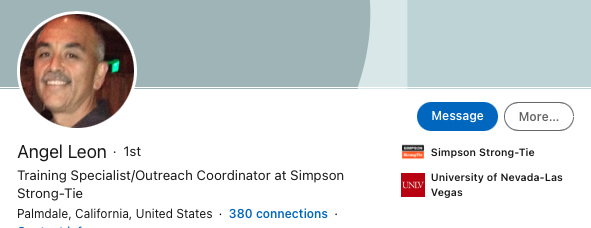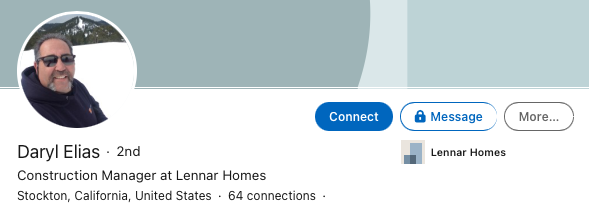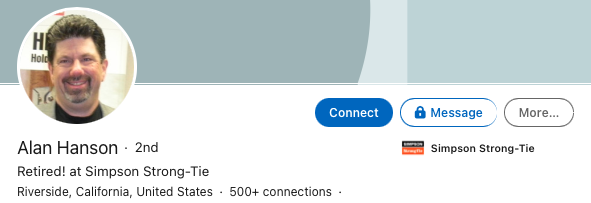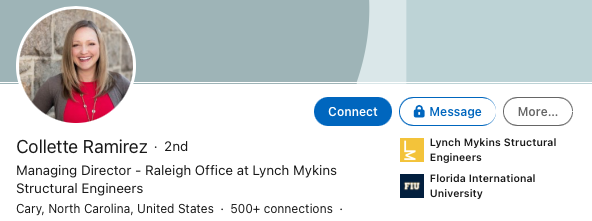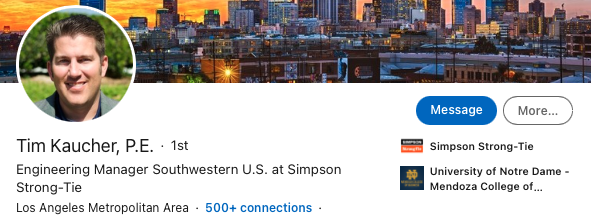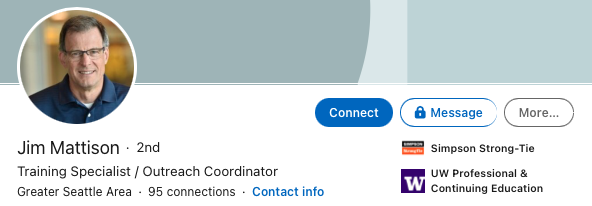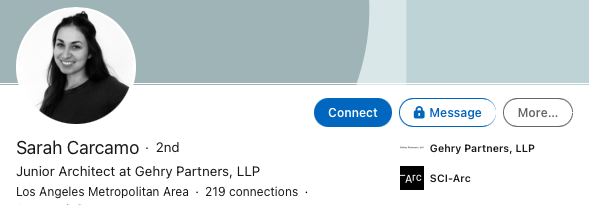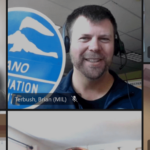Every year Simpson Strong-Tie hosts our scholarship students at our home office. It provides the students with an opportunity to meet face to face with experts in the industry, have one-on-one sessions with mentors, and tour our manufacturing and testing facilities. Not surprisingly to anyone, 2020 threw a pandemic-sized bucket of water on our annual plans. We needed to think outside the box to provide these students with opportunities to ask the questions they would have normally brought to California.
We considered a Zoom call, but in all honesty, by the time October rolled around (the month we were planning events for the students), everyone was a little bit burned out on video conferences. Around the time we were planning the session, we participated again in the annual Reddit Ask-Me-Anything with Northwest seismic and tsunami experts. We’ve always been impressed with the engagement on the platform, so we wondered if we could do something comparable for a student Q&A. Obviously, hosting the event on Reddit would have created moderation challenges because anyone with an account on that platform would be able to jump in.
After some research, we thought this might be an excellent opportunity to test out LinkedIn’s event feature. Typically, this LinkedIn feature is used for scheduling in-person or online events. It isn’t intended to be the event itself, so this was a little unorthodox, but we think the end result was quite successful.
We scheduled a two-hour block where our panel of experts would answer any questions the students posted. During those two hours, our panelists sat in on a separate GoToMeeting call where they discussed the posted questions and made sure they were all answered. Over the course of the event, we had 23 questions and 55 answers! The questions ranged from how to get started in the industry to how Simpson Strong-Tie has had to pivot due to the pandemic.
The one drawback to the LinkedIn format is that the archived questions and answers are only accessible to participants. We felt the content from the event was rich, however, and would be of interest to other engineering students. In an effort to free the information from LinkedIn’s restrictions, we’ve collected some of our favorite questions and have posted them below for everyone to read.
Adapting to on-the-job challenges
Did you ever face a time where a project didn’t go as planned? And if so, how did you approach the challenge? – Brenda V.
A1. We were asked to design a podium deck of uniform thickness. After the first design the builder was interested in bidding drop panels, so we redesigned accordingly. Then they decided to price it as a steel podium if we wouldn’t mind redesigning it a third time. We obliged because we wanted to care for the relationship of everyone involved, but it was difficult on our profit and schedule. The client went with the uniformly thick slab that we originally designed, and they were grateful we were willing to accommodate their curiosity. A more mature or experienced designer would have likely told them “No”. 🙂 – Doug Allen
A2. Brenda, there will always be projects and situations that don’t go as planned. Always be open-minded about what you’re facing and never get bogged down by the what. Keep asking and searching for the why and always be open to help from your team. – Angel Leon
A3. When projects aren’t going as planned, that’s when structural engineers and architects come in to help us work through the problems and find solutions. – Daryl Elias
I would like to hear about how you can adapt well in problem situations involving engineering. – Grace M.
A1. I always start by looking at challenges as an opportunities, not as problems. This makes it easier to get to a solution. All opportunities can be solved. – Angel Leon
A2. You’ll learn from many of the problems you experience – that is how you advance in your field. Take each obstacle as an opportunity. – Alan Hanson
A3. One thing we talk about often is being “right-brained” engineers. When it comes to solving problems, it’s important to think outside the box and look at all options. As Angel and Alan said, every problem is an opportunity to learn something new. – Collette Ramirez
What are some challenges on projects you have faced, and have any innovations developed from these challenges? – Cooper M.
A1. I can speak to Simpson Strong-Tie products themselves, such as the HDU-style holdowns. After the Northridge earthquake, we saw that a lot of our products were installed improperly. We took information from the field and developed new holdowns that are more difficult to misinstall. From that research and testing, the predeflected HD, with the fasteners included, was born.
There are a number of products that were born in this way — for example, SDS/ WSW screws, which do not require predrilling, a major innovation. – Alan Hanson
What have been some challenges the panelists have faced during their career and during the past year? – Corey C.
A1. Challenges I have faced range from relationships to design challenges to project challenges. I’ll give you an example of each kind.
Managing people is just as difficult as any other part of doing design or being involved with construction projects. Especially as deadlines are approaching and emotions run high, you want to keep your cool and stay focused on the job at hand. We all know what it’s like to have others not pull their weight on a group project. These challenges are very real and something we all have to deal with during our careers. Holding each other accountable in a fun, competitive way is a great way to work together and keep your efforts goal oriented. Have healthy boundaries for yourself and others. Take responsibility and communicate directly.
Design challenges can vary widely. For example, how do you retain soil 30′ deep with a typical foundation? How do you support 30′ of brick with a lintel? The biggest design challenge honestly is determining what problems you actually have to solve. If there are 45 concrete columns for a podium deck, how many do you design? If you design all 45 and detail each, you cause everyone more work: the fabricator, the detailers, the engineers, the inspectors, the erectors, etc. If you only design the columns, the job would also suffer. It’s about finding the sweet spot. Design a corner, edge, middle and any specialty columns. That would be reasonable for everyone.
One time on a project, we were doing a field observation and discovered the interior shear wall was parallel with the roof trusses, but there was no way for the shear in the roof diaphragm to get to the shear wall. The structural drawings didn’t call out how to do that, and we realized our oversight in not providing that detail. We contacted the truss manufacturer and they verified the truss could act as a drag strut if they put sheathing on the side of the truss. The sprinkler contractor then had to redesign the spaces that could be sprinkled due to the attic being divided by the sheathed truss. A design is only a great idea when it’s communicated clearly enough to be implemented during construction. – Doug Allen
Essential skills and personal development
What are some of the skills you’ve gained from working in your field and applying them to your personal life and side projects? – Jared B.
A1. One key skill I’ve learned by being in the industry is communication. Constant, clear communication is one key to successful projects and can also improve professional and personal relationships. – Collette Ramirez
A2. I was fortunate to be a carpenter/contractor for many years, which provided me an opportunity to learn rough framing. I can frame a large house in a handful of weeks with a few buddies. When I lived in Montana where many job sites are rural, I’d often get pulled into doing many phases of construction. It was easier to do multiple parts of the project that would otherwise be subcontracted out. I learned concrete finishing, deck building, roofing, siding, insulation, tile, cabinet installation, finish carpentry, drywall, painting, perfa taping, window and door installation, fascia, soffit, rain gutter, plumbing, electrical, and even installing garage doors. I’m eternally grateful for learning these trades and for gaining enough understanding to make me proficient in these areas. The understanding transfers well to other areas of life as well.
Take your talents and skill set and bless your community by doing service projects. If you stay engaged and intentional, you’ll be amazed at how your talents and skill sets will continue to magnify beyond your expectations.
There is no end to what you can learn. That may seem daunting, but I find it inspiring and beautiful. – Doug Allen
A3. I learned to build my own home and taught my children how to take care of themselves so they don’t have to pay someone to change a doorknob. – Daryl Elias
A4. Networking, networking, networking! It is the key to expanding your success in life. If you look at engineers as a whole most are not “people” people. Engineers aren’t naturally outgoing. That’s why joining a group such as the SEA or ASCE can pay dividends. – Alan Hanson
From what I’ve seen among general contractors, BIM modeling has greatly improved efficiency for construction managers. How often does a program or technology like that come out, and is training provided for these types of programs? – Brad T.
A1. In my role with Simpson Strong-Tie, I experienced the benefits of BIM mainly on multifamily projects. The main benefits I saw when working with contractors on these projects were the ability to identify and solve potential building issues before actually starting the build, which can save countless hours and tons of resources. It also emphasized communication and collaboration for all stakeholders on the project, which led to better working relationships between the trades. – Sam Marcoux
A2. BIM modeling is certainly an efficient tool enabling all trades to be involved with identifying issues typically found during construction. There are some design teams who are starting to require that on all projects moving forward, so all trades are getting involved. In the Southwest US, we have seen some building owners require it, too, since there are long-term benefits to them well down the road. Technology is something that continues to advance our profession and industry. We all need to continually be on top of such changes so we can ensure our companies can adapt along with them. – Tim Kaucher
A3. I heard at the NCSEA annual conference last week that there were actually some projects that had only a BIM model to construct from (no official construction documents), which was surprising to me. Granted, floor layout plans, etc., can be printed at any time. It made me curious whether the model was somehow protected or locked and how it was “sealed” as a snapshot in time as the official design. Interesting challenges arise with these changes. – Doug Allen
Coming from the construction side of the industry, I often hear about disagreements arising between the construction management team and the architects or engineers. How do you go about developing a relationship with the other partners to ensure that everyone is on the same page and that there is effective and efficient problem solving? Please touch on both technical and interpersonal solutions. Thank you very much to all the panelists! – Brett S.
A1. I always start a project by reminding everyone that we’re a design team and we all have the same goal of getting the project done well. At the end of the day it all boils down to good communication. Be open and honest and come with solutions. – Collette Ramirez
A2. Treat all members of the A & E team with respect and kindness regardless of their role in the project. Problems and differing perspectives will arise. Direct and constructive communication will go a long way toward maintaining a team approach throughout the project. It’s imperative that the jobsite superintendent and the project manager establish a culture of mutual respect, teamwork, and open and honest communication. Having built a 14-story building right out of school, I know these things to be true. Thanks for your question. – Jim Mattison
A3. Remember, construction professionals are experts in their field, but usually not in everyone else’s. Try to have patience and “take a walk in their shoes” and have empathy. – Alan Hanson
A4. Communication is key, as it is in any relationship, but even more so when the stakes are high. Communicate early and directly to identify scope and expectations. Ask for clarification when need be. Give others the benefit of the doubt —assume they are on your team and want a winning outcome, too. Integrated project delivery methods demanding collaborative teamwork are becoming more common. When there is an RFI or request for a change, suggest the change you prefer to get to an agreeable solution faster. – Doug Allen
I would love to know if any of the panelists have dealt with ‘Imposter Syndrome’ and how you overcome or deal with it? I would also like to know about how you discuss salaries and how you know how much you are worth, without over- or underselling yourself! – Noelle Y.
A1. Self-doubt is a bugger. Even if you’ve trained for a marathon for months, you’ll fight self-doubt, but one of the things you can combat it with is remembering what you’ve done.
The best negotiation is a win/win. Meaning enter it knowing what you would need or be happy with — it is likely a range. During negotiation you can be informed of the range that they are looking for and hopefully there is some overlap. Also, keep in mind that salary is only a portion of the compensation package, so be creative in your negotiations and you may come away with more of what you actually care about. – Doug Allen
A2. It’s funny that you bring up Imposter Syndrome because I was just researching and reading a ton of articles about this recently. Time.com has a great read that I will link below on this issue that dives into how to overcome it. As for the salary discussion, my advice is to be informed of what the market rate is for your chosen profession and don’t be afraid to highlight your unique strengths. (This is a really tough skill to develop. It’s naturally difficult for most people to talk about themselves in these terms.). – Sam Marcoux
I would like to hear the panelists discuss how they go about not having enough technical knowledge in any area. Do you ask your colleagues for help, or do you stick with doing research all on your own? – Bakri A.
A1. We have a robust training department that has created a large online library of courses for education about various topics — see strongtie.com. Engineers are asked to work in their “area of expertise,” which is hopefully constantly developing. There is an old adage “if you don’t use it, you lose it” which is unfortunately true in many regards. As much as you may study a certain technical topic, you will soon forget the material unless you use it often enough to have it really ingrained in your understanding. – Doug Allen
I would love for the panelists to discuss their individual career paths, specifically how networking vs. their technical skills and experience may have gotten them the job! – Eileen T.
A1. NETWORK, NETWORK, NETWORK!! Relationship is KEY in all career paths. Meeting people and creating good relationships is extremely important. This is NOT to say technical skills don’t get you to where you want to go. They certainly are necessary. I love/hate the phrase “It’s not what you know, it’s who you know,” because obviously you need to know the industry, have a bachelor’s in architecture to get hired. Nevertheless, without creating professional relationships I wouldn’t be in the position I am today. Here’s my personal experience for those interested: During my five years at SCI_Arc, I was always participating in class. This alone can help you form a working relationship with your instructor. It’s often asbasic as that. I attended many lectures and exhibition openings that a lot of my colleagues and professors also hung out at. Being present allows people to also remember your face easier! I applied for the Simpson Strong-Tie scholarship, and it enabled me to meet successful and fascinating people within the industry, create wonderful relationships with colleagues, and finally even become a panelist at a Q&A for students!
An instructor I had in a previous year at SCI_Arc needed a teacher’s assistant, and I was emailed and asked if I wanted to fill this role. (Without my constant attendance and participation and the relationship they helped me forge, I doubt I would have received this email.) As a teacher’s assistant, I was able to practice and challenge my leadership skills as well as strengthen the trust with said instructor. Once I graduated, this same instructor asked me if I had an interest in working at Gehry Partners. This instructor used to work there for many years before creating their own firm. I was able to get an interview right away and then got hired a few weeks after graduating. In fact, the class that I took with this instructor was probably my worst outcome related to grades. It was one of the most difficult for me for some reason, and it wasn’t one of my best grades. I almost failed it. But I never gave up, and my professor did not let this go unnoticed! Exaggeratingly: technical skills for this class: 0 Networking: 1 (winning) – Sarah Carcamo
A2. Anytime I’ve changed jobs, and even when I got my first job, it was through relationships. People want to work with people that they know, like, and trust; and the more relationships you develop, the more people there are who can help you when you’re ready to find a job or make a change. I met my current boss about one year before I actually got hired. I knew I really wanted to work for the company and spent time developing a relationship with her and some of the other engineers so they could get to know me. When they were ready to hire, I was the first person they called! Technical skills are definitely important, but so many times the relationship will get you that first interview. – Collette Ramirez
A3. I come from a background of construction and on-the-job learning. I had a lot of mentors and people teach me the ropes. My persistence has landed me some of my best jobs. – Daryl Elias
A4. Participate in as many teacher’s assistantships, clubs and trade organizations, school competitions, and other professional activities as you can — they’re invaluable! – Alan Hanson
Getting started in the industry
I would like to discuss how the speakers chose this industry as their career path and what their favorite part of the job is. Additionally, I would love to learn about the process of owning a construction/engineering firm. – Auburn M.
A1. I got interested in the field of architecture after seeing it firsthand through a family member who teaches architecture. I saw over my shoulder what he was working on, and I became deeply curious and began to question what exactly architecture WAS, and what does it mean to be an architect?? My favorite part of my job is watching where the collaboration and designing go in the real world. This is not really experienced during school. This is something experience in the field can get you. In the field as an entry-level architect, you get to see hands-on where the design concept can go and how it can be developed based on design, codes, consultant coordination, etc. Whether this means model making in a Schematic Design — or drawing details for a submission in Construction Development — it’s quite wonderful to see the different types of detail the development of a project delivers in all phases of design. I highly suggest interning as much as possible: — Creating relationships and coming to understand project delivery at different scales of projects and firms allow you gain experience and to find your personal niche. – Sarah Carcamo
I read in the introductions that Doug Allen, P.E.owned a construction company. What is the hardest part about owning your own company? – Auburn M.
A1. Doing the actual work of constructing homes is a challenge, but as an owner of a construction or design company you also have to get projects to keep yourself in business. This takes putting bids out, collaborating with others, lining up subcontractors, and staying on schedule. Managing expectations is so very important. Managing the expectations of your customer, your investors, your employees, your vendors, your partners takes attention and communication. We all know what it’s like to be disappointed by expectations that weren’t met. We don’t have to be perfect, just keep everyone up to speed about what to expect. – Doug Allen
This question is for Sarah Carcamo. How is it working at Gehry Partners? What is the studio structure like? Also, what advice do you have for graduating arch majors on their portfolio or resume to get into a firm like Gehry Partners? – Henry C.
A1. Working at Gehry Partners is such a wonderful experience. Being able to work on multiple project scales, working closely on design intent with Frank Gehry — every project is a great learning experience, design and coordination wise. The studio structure is an open studio concept, similar to that of architecture school. I strongly suggest applying for scholarships and taking on internships during summer breaks in the related fields. My first internship was with an interior design firm when, ultimately, I wanted to be at an architecture firm. Scholarships help you financially but also open opportunities to create relationships within the field. Internships not only give you experience, but also creates relationships that can lead to opportunities in the future! Don’t be too picky as to where you intern. It’s best to get your foot in the door somewhere and expand from there! – Sarah Carcamo
What do you wish you would have known before you entered the industry? – Anna B.
A1. Take marketing and business classes. Anything that makes you more rounded is beneficial. – Alan Hanson
A2. Something in finance is another really good thought. Whether you own your own firm one day or work your way up to senior leadership in charge of segments, you might be responsible for the profit and loss of that space. Learning this ahead of time would be good. There is a good book out there called Financial Intelligence – A Manager’s Guide to Knowing What the Numbers Really Mean by Berman and Knight. It’s really a financial book for those who are not in finance specifically. High-level stuff! – Tim Kaucher
A3. Practice public speaking. If you aren’t comfortable speaking in front of others, take a class or join Toastmasters. When I was in construction, I was always reluctant to speak up during a project meeting with the A and E – and even among my construction peers. Surveys have shown that people say they prefer dying to public speaking. – Jim Mattison
A4. I wish my graduate program had courses in project management and communication. While the technical side is definitely critical, communication is equally important to the success of a project. – Collette Ramirez
A5. Prior to working at Simpson Strong-Tie, I was a general contractor, and I wish I had taken some business management courses and training. – Angel Leon
A6. A structural engineer only makes 1% of the project cost, but a realtor makes 3%. – Doug Allen
A7. I had to learn most of the structural on the job. If I had had schooling in that area, it could have been helpful. – Daryl Elias
I would like to hear any tips that panelists have for creating better relationships with contractors and within their industry as a whole. – Eli B.
A1. Always approach potential customers and contractors with what you can do for them. How can you make their job easier for them? Show that only you can get this completed as a TEAM! – Angel Leon
I am curious about the main differences between architects and structural engineers in their day-to-day work. – Hayley H.
A1. There is a lot of collaboration between structural engineers and architects in my experience. The structural engineers send over a general markup based on the schematic plans the architect has, and then it gets incorporated back into the design models, etc. This collaboration certainly helps drive the design sometimes. Often architects like to challenge this, and having a good relationship with the structural engineers allows this flexibility and back-and-forth collaboration to happen. – Sarah Carcamo
A2. As a structural engineer focused on building design, I work very closely with architects to provide the required support for the building. As Sarah mentioned, there’s a lot of collaboration back and forth to determine the right structural system, structural locations based on the architectural layout, and how to support special architectural features. – Collette Ramirez
A3. Architects typically manage more of the overall design — a structural engineer only works on 1/10 of what an architect must consider (their fees typically reflect this, too). An architect decides the materials, structural assemblies, waterproofing details, occupancy use, egress, accommodations, etc. A structural engineer must be an expert at materials, geometry, and mother nature. – Doug Allen
I would like to know about some of the major factors that influence employability in the construction/engineering field. For example, what qualities, characteristics, and experiences tend to make you more appealing as a potential hire? – Joel G.
A1. We have a joke internally that we like to hire “Engineers with Personalities,” meaning that you should be someone that can hold the attention of an audience. My mentor told me one of the best measures of being a great employee is being “easy to work with.” Soft skills are important, being able to communicate clearly, in writing or speech, is essential. Gaining experience is also irreplaceable, because you develop your engineering judgement by navigating problems to solutions. Being a team player is not only attractive, it’s essential. Make the people around you look good, and you will make yourself valuable. – Doug Allen
A2. Be a good person! No one wants to hire someone who they wouldn’t want to hang out with. Also, join clubs and organizations which cater to your industry. SEA, ASCE, EERI (for engineering students). Also, participate in as many extracurricular activities as possible, such as concrete canoe, steel bridge, etc. – Alan Hanson
A3. You need to be teachable and coachable. Know that you will never know it all. – Angel Leon
What are some important things to consider when evaluating entry-level engineering positions? For instance, what did the panelists find to be the most impactful elements of their jobs when they were starting out? – Derek L.
A1. I think the first thing is to really think about what you’re looking for in a position. Do you have a specific design that you’re interested in? Would you prefer being at a large firm or a small firm? What kind of culture are you looking for? As for an actual position, something that was really important to me was getting exposure to all types of building materials and projects. I wanted to be at a firm where I would have the opportunity to learn about every construction type and be involved in a project from start to finish. – Collette Ramirez
A2. A lot of graduating students decide to work at a larger firm, partially because that’s who’s at campus trade shows and SEA/ASCE meetings. Then, after they “learn the ropes,” they may decide to go to a firm that’s more their style or size. Remember, when you’re in an interview, you are trying as much to learn about their culture as they’re trying learn about you. – Alan Hanson



